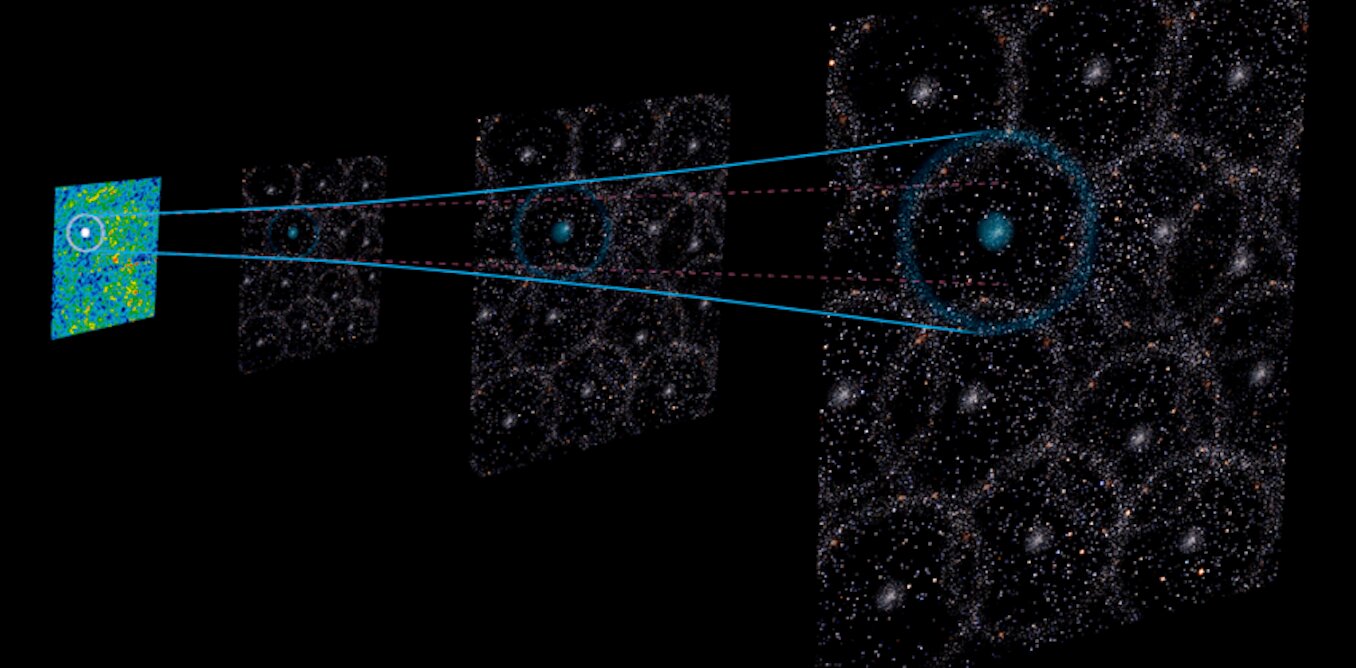🔭 Our place in the Universe may be special, and this explains many things
Published by Adrien,
Source: Monthly Notices of the Royal Astronomical Society
Other Languages: FR, DE, ES, PT
Source: Monthly Notices of the Royal Astronomical Society
Other Languages: FR, DE, ES, PT
Follow us on Google News (click on ☆)
Astronomers long believed that the distribution of galaxies around us was representative of the Universe as a whole. Yet recent observations indicate we might reside in a vast underdense region, a 'cosmic void'. This discovery challenges some of our certainties about the structure of the Universe.

Baryon acoustic oscillations, sonic witnesses of the Big Bang.
Credit: Gabriela Secara, Perimeter Institute, CC BY-SA
The study published in Monthly Notices of the Royal Astronomical Society is based on the analysis of baryon acoustic oscillations (BAO). These patterns, imprinted in the cosmic microwave background, serve as standard rulers for measuring the expansion of the Universe. The results support the hypothesis of a local void, with a significantly higher probability than models without a void.
The Hubble tension, a disagreement about the expansion rate of the Universe, might find an explanation in this discovery. The movement of matter out of the void could create the illusion of faster expansion. This theory offers an elegant solution to one of the greatest mysteries of modern cosmology.
Future observations of BAO at low redshift will be important to confirm this hypothesis. They could reveal even more pronounced distortions, strengthening the idea that we inhabit a special region of the Universe. This perspective opens new avenues for understanding the fundamental laws that govern our cosmos.
Meanwhile, the scientific community remains divided. Some researchers warn against hasty conclusions, pointing out that other explanations for the Hubble tension are possible.
What is the Hubble tension?
The Hubble tension refers to the discrepancy between current measurements of the Universe's expansion and predictions based on the standard cosmological model. This difference, of about 10%, poses a serious problem for physicists.
Local measurements, such as those from supernovae, suggest faster expansion than that deduced from the cosmic microwave background. This contradiction might indicate a flaw in our understanding of physical laws or the properties of the Universe.
Several theories attempt to explain this tension. Among them, the existence of dark energy more complex than expected, or modifications to the laws of gravity. The discovery of a local cosmic void offers another lead, less radical but equally intriguing.
Solving this mystery will require more precise observations and perhaps new instruments. The coming years could mark a turning point in our understanding of the Universe.
How do BAO inform us about the Universe?
Baryon acoustic oscillations are pressure waves that traversed the primordial Universe. They left imprints in the distribution of galaxies and the cosmic microwave background.
By studying these patterns, cosmologists can reconstruct the history of the Universe's expansion. BAO act as standard rulers, allowing measurement of cosmic distances with great precision.
These measurements are essential for testing cosmological models. They notably help constrain the properties of dark energy and dark matter, two still mysterious yet dominant components of the Universe.
Technological advances, such as large galaxy surveys, are constantly improving the precision of these measurements. BAO will remain a key tool for uncovering the Universe's secrets in the decades to come.